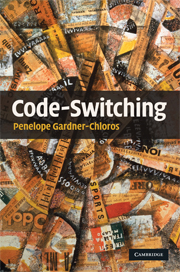
-
Select format
-
- Publisher:
- Cambridge University Press
- Publication date:
- 10 February 2010
- 25 June 2009
- ISBN:
- 9780511609787
- 9780521862646
- 9780521681131
- Dimensions:
- (228 x 152 mm)
- Weight & Pages:
- 0.54kg, 254 Pages
- Dimensions:
- (228 x 152 mm)
- Weight & Pages:
- 0.41kg, 254 Pages
- Subjects:
- Sociolinguistics, Language and Linguistics
You may already have access via personal or institutional login- Subjects:
- Sociolinguistics, Language and Linguistics
Book description
It is quite commonplace for bilingual speakers to use two or more languages, dialects or varieties in the same conversation, without any apparent effort. The phenomenon, known as code-switching, has become a major focus of attention in linguistics. This concise and original study explores how, when and where code-switching occurs. Drawing on a diverse range of examples from medieval manuscripts to rap music, novels to advertisements, emails to political speeches, and above all everyday conversation, it argues that code-switching can only be properly understood if we study it from a variety of perspectives. It shows how sociolinguistic, psycholinguistic, grammatical and developmental aspects of code-switching are all interdependent, and findings in each area are crucial to others. Breaking down barriers across the discipline of linguistics, this pioneering book confronts fundamental questions about what a 'native language' is, and whether languages can be meaningfully studied outside of the individuals who use them.
Reviews
'The volume does remind us that sociolinguistics has long been convinced that language can tell us something not only about specific social phenomena, but also about the big questions of how cognition, interaction and social structuration are linked.'
Source: Journal of Sociolinguistics
'This excellent and engaging book is prefaced by a version of the Indian (or perhaps ultimately Chinese) story in which a number of blind men grasp different parts of an elephant (the trunk, the tail, the tusk), thus reaching divergent conclusions about the beast’s salient characteristics. Penelope Gardner-Chloros uses this history to illustrate her sense that the concept of code-switching (CS) is understood and operationalised rather differently by scholars and researchers approaching it from various angles (formal linguistics, psycholinguistics, sociolinguistics).'
Brian Poole Source: sciencedirect.com
Contents
Metrics
Altmetric attention score
Full text views
Full text views help Loading metrics...
Loading metrics...
* Views captured on Cambridge Core between #date#. This data will be updated every 24 hours.
Usage data cannot currently be displayed.
Accessibility standard: Unknown
Why this information is here
This section outlines the accessibility features of this content - including support for screen readers, full keyboard navigation and high-contrast display options. This may not be relevant for you.
Accessibility Information
Accessibility compliance for the PDF of this book is currently unknown and may be updated in the future.


